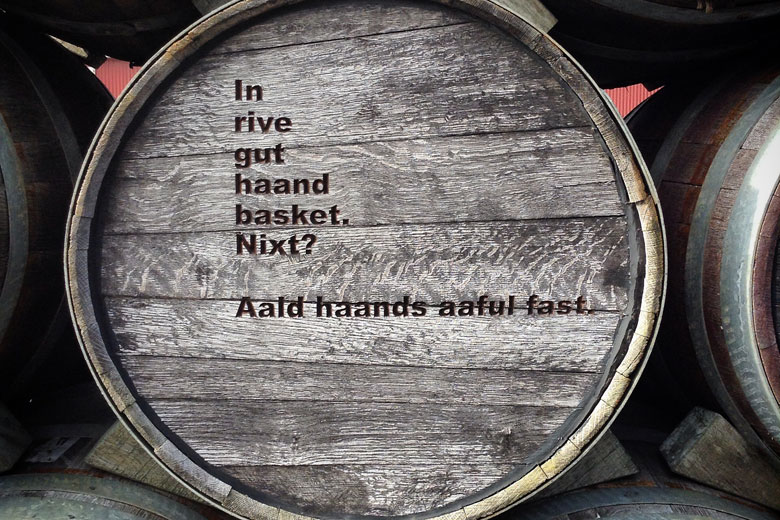Then and now
Shetland-based blogger Elizabeth Atia finds out that while times have changed, herrings continue to shape the lives of the islands’ people. Additional reporting by Christian Smith.
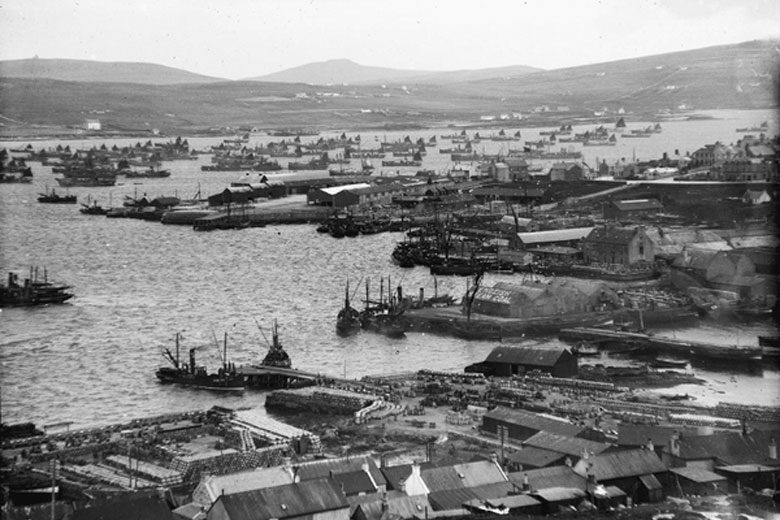
“There were none of these big ships in Lerwick harbour then; there were herring drifters. From north of the Bressay ferry terminal all the way to Rova Head there was nothing but herring stations where hundreds and hundreds of tonnes of fish were gutted and processed.”
I’m chatting with Cecil Craigie, an elderly ex-whaler, one of the many Shetland fishermen who were recruited by boats stopping off to crew and victual on their journey north to the Arctic hunting grounds of the Svalbard archipelago – tough work. He sits before me, youthful eyes glinting from a face etched by years of wind and waves, remembering what Lerwick was like a generation ago, when Shetland still dominated the herring fisheries in Europe, as it had for centuries.
“The herring came from Iceland, down the coast of Shetland to the mainland of Scotland. The boats didn’t have all this fancy equipment to find them either. You watched for the solan geese [gannets] diving. Where they dove, that’s where the herring was.
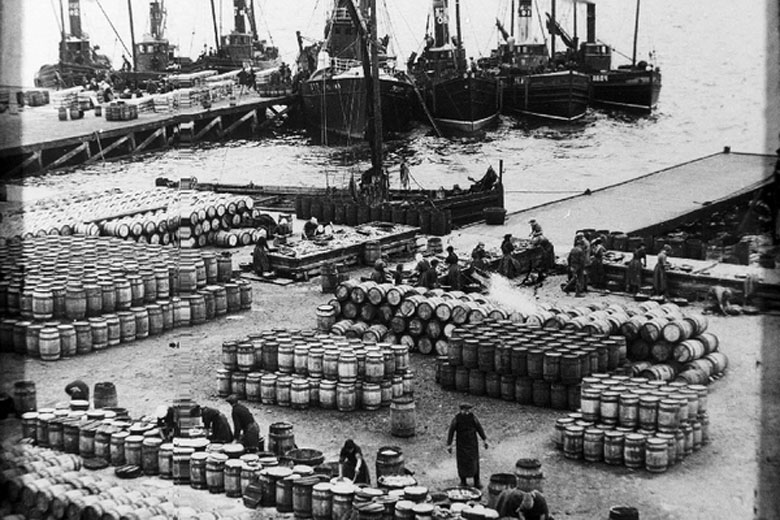
“My father and brother were coopers, making barrels for different stations, and when all the boats were in with the bad weather, you could almost walk across the water to Bressay. That’s where the herring heads and entrails were taken by flitboat each day, to be turned into fish and bone meal. If the wind was in the east, things got rather smelly in Lerwick!
“My mother was a gutter cleaning the herring ready to be salted for East Germany, Poland and elsewhere. Salt herring was the thing then. We used to have it for dinner once or twice a week, if we were lucky.”
As we’ve written about before, the herring changed women’s lives here in Shetland. For the first time they had the chance to earn their own money while the men were away at sea; to have a life outside of crofting, knitting and domestic service. In 1909 the Shetland herring industry employed 14,000 people, 1,670 of them women. And that doesn’t include the hundreds more who travelled south to gut at stations throughout Scotland and England, following the herring on their journey down the east coast.
That way of life continued well into the 1960s, until over-fishing caused herring stocks to collapse, leading first to wholesale fishing bans, then strict regulation. A second, less significant collapse happened in the 1990s, but stocks have since recovered and herring once again plays a major role in Shetland life, albeit in a very different way.
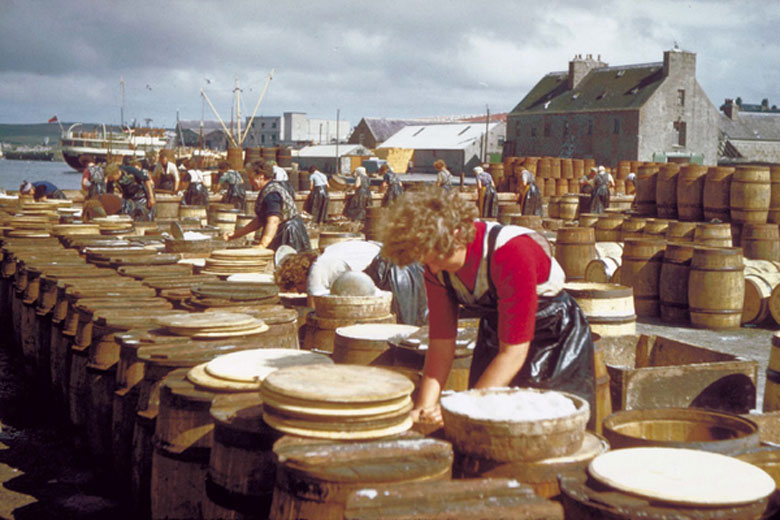
Today Shetland prides itself on having the most modern pelagic fleet in the world. And for the past 25 years, Lerwick, Shetland’s main town, has been home to Shetland Catch, now Europe’s largest primary processing plant of pelagic fish, the term for fish that live above the bottom and away from the shore. Shetland, Scottish, Irish, Norwegian, Swedish and Danish vessels all land their catch here while the fish are at peak freshness. The traditional herring catch is processed here from June to the end of September, followed by horse mackerel (November to January) and blue whiting (February to April), with mackerel, the bulk of the business, running alongside from August through to February.
This summer, to mark its 25th anniversary, Shetland Catch held an open day at the plant, attracting more than 1000 visitors – including me. One of four giant cold stores, which normally hold 11,500 tonnes of fish, was converted into a photo gallery displaying the company’s history. “It can be difficult for people to fully appreciate the sheer scale of our operation, so we decided to invite them in to see the process for themselves,” says Simon Leiper, managing director of Shetland Catch.
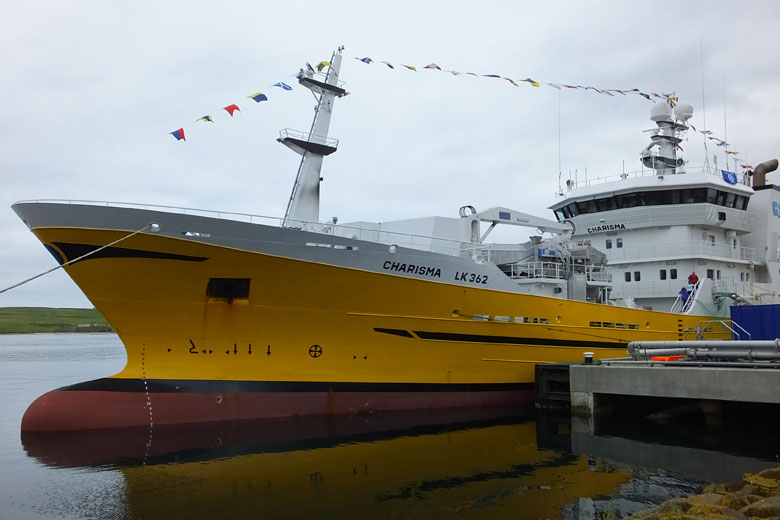
Outside, at the harbourside, two Shetland Catch vessels, the Adenia and Charisma, were also open to the public – as was the restored herring drifter the Swan, originally built in Lerwick in 1900. A spokesman on the Swan explained that there used to be 400 herring drifters like her fishing the local waters; now there are just nine modern pelagic vessels. That might not seem many – until you see one.
Just under 71m long with an 8,000 horsepower engine and side thrusters, the modern Charisma towers over the old Swan. It’s bristling with modern electronic equipment such as sonar, net and catch monitors, greatly improving precision and minimising bycatch and catch of under-size fish. It can catch hundreds of tonnes of fish on a single trip, but its annual total is capped by the amount of quota it has. Such vessels can get through this pretty quickly and so can spend much of the year tied up, rather than at sea, hence they are often likened to combine harvesters.

This formidable efficiency is continued at the plant: within 24 hours of landing, a catch can be processed, packed and on its way to market. Destinations include Russia, Ukraine and Nigeria, as well as the UK, France and Germany. (Although Russia’s recent import bans have closed that market for a while.)
While the open day was a fascinating insight into modern fishing, what really struck me was how quiet and clean the factory was with all the machinery shut down. So I returned a month later, one week after the first catch of the year was landed by the Scottish vessel Sunbeam. After donning wellie boots, a hair net and protective jacket I was given a very thorough tour by Paul Ratter, the quality control manager. In stark contrast to the open day, it was busy, wet and very loud.
Paul explained that when Shetland Catch opened, they were only processing 150 tonnes of fish per day. Now, with reinvestment and improvements in technology, they can process up to 1,000: the new Baader filleting machine can fillet an astonishing five fish per second. Factory employees were all wearing earplugs and waterproofs, the only pause coming when Paul shut down the machines for a few moments to remove a herring that was jamming the works.

Speed and capacity aren’t the only things to have changed since Shetland Catch started trading. These days, all the Scottish pelagic fisheries are MSC certified, thanks in large part to Shetland Catch: it helped set up the Scottish Pelagic Sustainability Group, founded in 2007 to get everyone involved in the North Sea herring and western mackerel fisheries to help with the certification process.
The certification process is rigorous. “It’s similar to being audited,” explains Shetland Catch chairman John Goodlad. “There are three main areas: stock management and quota, fisheries management and impact on the wider environment.” To be certified, fisheries must avoid practices that lead to overfishing or depletion of target stocks, promote responsible and sustainable fishing and take steps to minimise any damage to marine ecosystems.
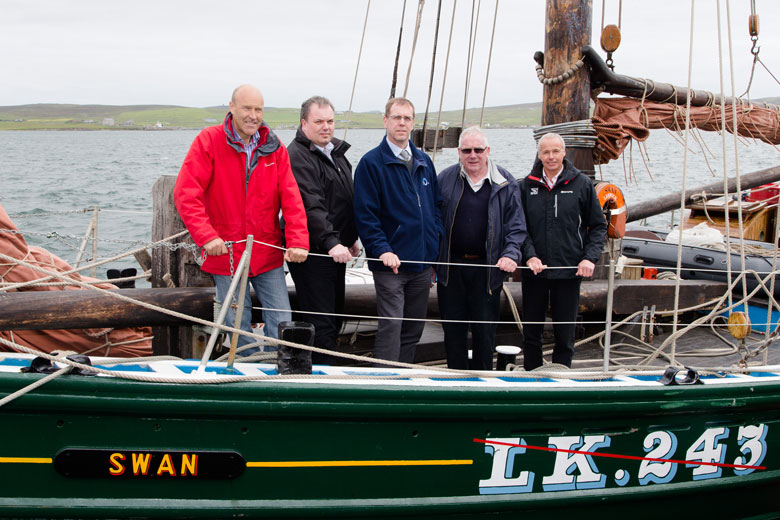
The MSC initiative was an important development, because the environmental record of pelagic fishing in the early 2000s still wasn’t good, plagued by over-quota landings. Shetland Catch itself broke EU quota rules between 2002 and 2005, processing thousands of tonnes of illegally landed mackerel and herring. It was eventually fined £150,000 and ordered to pay back £1.5m in profits.
Things have come a long way since then. The North Sea herring fishery was first certified in 2008, with western mackerel following in 2009 (although this is currently suspended pending resolution of a dispute with Iceland and the Faroes) and two other herring fisheries in 2010 and 2011. According to the MSC’s Global Impact Report 2013: “Since the first big pelagic North Sea herring fishery was certified in 2006, this stock has increased more than 15 per cent and rebuilt to above target levels due to a successful rebuilding plan and improved information and enforcement on discards.”
“Becoming MSC certified is something we are very proud of,” says John, “not just on behalf of Shetland Catch but for the whole Scottish pelagic industry.” And there are tangible benefits too. “Certification opens up access to markets that only accept MSC fish,” says John. “It’s also a way of demonstrating to the public, press and politicians that we’re doing the right thing by fishing in an environmentally conscientious way.”

Elizabeth Atia is a food blogger living in Shetland. She has a passion for local produce and enjoys researching and sharing the stories behind the ingredients and recipes she cooks on her blog at Elizabeth’s Kitchen Diary .



